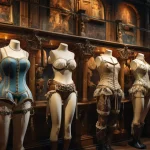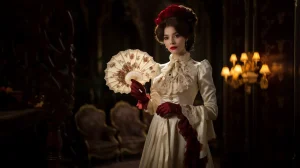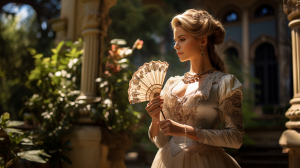
How Prison Uniforms Got Their Stripes: A Victorian Era Exploration
Imagine strolling down a fog-laden street in Victorian England, an era dripping with a curious blend of elegance and severity. Here, in the shadows of grandiose architecture and amidst the whispers of societal reform, lurks a tale as stark and striking as the stripes on a prisoner’s uniform. It’s a story that intertwines with the very fabric of Victorian society, where the opulence above was mirrored by the control below, in the depths of the penal system.
This is a journey back in time to explore how prison uniforms got their distinctive stripes, a design as symbolic as it was practical. It’s a dive into a past where fashion wasn’t just a statement of style but a tool of societal control, a visual representation of the shift from physical shackles to psychological chains.
The Victorian era, famed for its strict social norms and profound cultural shifts, was also a time of significant penal reform. In the midst of these changes, the prison uniform underwent a transformation, adopting the iconic stripes that have since become synonymous with incarceration. But why stripes? Was it merely a fashion statement, or was there more to these horizontal bars than met the eye?
As we unravel this sartorial mystery, we’ll explore the origins of these infamous stripes, their role in the broader context of Victorian penal reform, and their lasting impact on society’s perception of crime and punishment. From the dark, damp cells of Victorian prisons to the modern-day debate on prison attire, the striped uniform stands as a testament to an era’s attempt to redefine justice and control.
So, let’s embark on this raw and revealing journey through time, exploring the intriguing story behind the stripes, a pattern that marked not just the clothes of the condemned but also the mindset of an era.
Origins of the Striped Uniform
The Emergence of the Striped Ensemble
In the heart of the 19th century, amidst the clatter of industrial revolution and the stiff upper lip of Victorian propriety, the world of penal fashion witnessed a radical shift. The birth of the striped prison uniform wasn’t just a change in fabric; it was a reflection of a society grappling with the concepts of order, morality, and control.
The Early Days of Penal Attire
Before the stripes, prison garb was a haphazard affair. Inmates were often clad in whatever tattered remnants were available, making them indistinguishable from the poorest of the poor. This lack of uniformity, however, ran counter to the Victorian ethos of order and classification.
The Decision to Adopt Stripes
Stripes emerged as the chosen pattern for several compelling reasons. Visually striking, they served as an instant identifier, separating the incarcerated from the free, the ‘immoral’ from the ‘upright.’ The pattern was simple yet impossible to ignore – a constant, visual reminder of a person’s criminal status.
Symbolism of Stripes
In the Victorian mind, stripes represented more than just a pattern; they were imbued with symbolic weight. Stripes were the antithesis of the era’s fashionable attire, a deliberate inversion of the elegance found in the upper echelons of society. To wear stripes was to be marked as ‘other,’ a walking embodiment of dishonor.
Global Comparisons
Interestingly, the adoption of striped uniforms wasn’t limited to Victorian Britain. Around the globe, various penal systems embraced similar patterns, each interpreting the stripes in their own cultural context. This global trend underlines the broader shift in how society viewed crime and punishment – a shift from physical brutality to psychological control.
In this section, we’ve scratched the surface of the origins of the striped prison uniform, revealing a complex interplay of societal values, penal philosophy, and fashion. As we delve deeper into the Victorian era and its reforms, we’ll uncover how these stripes became a pivotal part of the era’s narrative of control and morality.
Victorian Era – A Time of Transformation
Reform and Representation in Victorian Prisons
As we navigate through the smoggy alleys of Victorian reform, it’s clear that this wasn’t just an age of corsets and carriages, but also one of chains and chastisements. The prison system, much like the society it sought to correct, was in the midst of a metamorphosis, with the striped uniform at its very core.
The Victorian Penal System: A Theatre of Reform
This era was no stranger to the concept of reform. Prisons were evolving from mere holding cells of despair into institutions of moral correction. The introduction of the striped uniform was a cog in this larger machine of societal change. It was about breaking spirits, remolding characters – a visual cue of the system’s authority and the individual’s subservience.
Discipline and Hierarchy in Fabric
In the world of Victorian incarceration, the striped uniform was more than just attire; it was a tool. It instilled discipline, a constant reminder to the inmates of their place in the hierarchy of morality. Wearing stripes was akin to bearing a badge of shame, a perpetual stain on one’s character, visible for all to see.
Psychological Impact of the Striped Attire
The true genius (or tyranny, depending on your view) of the striped uniform was its psychological effect. These weren’t just clothes; they were a type of mental shackle. Stripes ensured that prisoners were always seen as less-than, a walking symbol of wrongdoing. This psychological branding was as potent as any physical punishment, maybe even more so. It was a relentless reminder of the fall from societal grace, an inescapable mirror of one’s transgressions.
In this gritty narrative of Victorian reform, the striped uniform stands as a stark symbol of the era’s approach to crime and punishment. It’s a story of control, of a society’s attempt to rewrite the moral compass of its deviants. As we continue our journey, we’ll delve into the very design of these stripes, uncovering the layers of meaning stitched into every barred pattern.
The Design and Symbolism
Stripes: More Than Just a Pattern
Diving deeper into the heart of this tale, we find ourselves peering into the very threads of the striped prison uniform. It’s a concoction of fabric and symbolism, each stripe woven with a purpose, each seam stitched with an intention.
The Deliberate Design Choices
Victorian prison uniforms were a masterclass in intentional design. The choice of stripes was no random act. These lines served multiple purposes: they were instantly recognizable, difficult to conceal, and visually jarring. The uniform was crafted to be the antithesis of freedom and individuality – a sartorial straightjacket, if you will.
Symbolism Sewn into Each Stripe
Each stripe on the uniform was a silent sentinel of order and control. The pattern was a visual representation of the era’s rigid social structures, a stark contrast to the fluid fashions of Victorian high society. For the inmate, these stripes were a constant reminder of their fall from grace, a badge of dishonor that they wore every waking moment.
The Psychological Warfare of Attire
The real power of these uniforms lay in their ability to wage psychological warfare. They weren’t just garments; they were tools of dehumanization. In a society obsessed with appearances, to be striped was to be stripped of one’s identity, reduced to a mere number in a system of systematic control. It was a daily, unrelenting assault on the psyche, a way to keep the incarcerated in a perpetual state of subservience.
In this exploration of the design and symbolism of the Victorian prison uniform, we’ve uncovered a narrative that goes beyond mere cloth and thread. It’s a story of societal expectations, of a system’s need to label, control, and diminish those it deemed unworthy. The striped uniform wasn’t just a piece of clothing; it was a symbol of an era’s struggle with the concepts of crime, punishment, and morality.
Societal Impact and Public Perception
The Stripes in the Public Eye
As we shift our gaze from the grim walls of Victorian prisons to the broader societal canvas, the impact of the striped prison uniform becomes even more pronounced. These stripes didn’t just encase the bodies of the incarcerated; they etched themselves into the public consciousness, a constant, stark reminder of the thin line between order and chaos.
A Visual Marker in Society
The striped prison uniform served as a visual marker, a societal tool for marking the ‘other.’ It was a stark, unmissable signal of a person’s fall from societal grace. In a culture where appearances were paramount, these stripes were a blight, an indelible mark that branded not just the fabric, but the very soul of the wearer.
Literary and Artistic Reflections
The influence of the striped prison uniform extended into the realms of literature and art. Writers and artists of the era often depicted these uniforms as symbols of the era’s attitudes towards crime and punishment. In these creative expressions, the stripes often embodied the tension between the individual and the system, between punishment and reform.
Stigma and Societal Control
The true power of the striped prison uniform lay in its ability to stigmatize. It was a tool for societal control, a way to visibly mark and marginalize those deemed deviant. This form of branding went beyond physical punishment; it was a psychological tactic, designed to reinforce societal norms and deter deviation.
In this section, we’ve explored how the striped prison uniform transcended its fabric confines to become a potent symbol in Victorian society. It wasn’t just a garment; it was a manifestation of the era’s complex dance with morality, justice, and social order.
Evolution and Modern Perspectives
The Legacy of Stripes in Modern Correctional Attire
We’re now at the tail end of this gritty journey, looking back at the striped prison uniform not just as a relic of the past but as a precursor to the modern narrative of incarceration. The legacy of these stripes is a complex tapestry, woven into the very fabric of how we view punishment and rehabilitation today.
From Stripes to Contemporary Fashion
The striped prison uniform has largely fallen out of fashion, replaced by more nondescript attire. However, the transition from stripes to the modern prison uniform is more than a mere change in style; it’s a reflection of an evolving approach to criminal justice. Today’s uniforms may lack the visual punch of the stripes, but they continue to serve a similar purpose: marking, controlling, and dehumanizing.
Reflections on Historical Perspectives
Our current penal policies are, in many ways, echoes of the past. The psychological impact of prison attire remains a contentious issue. While we’ve ditched the overt symbolism of the stripes, the underlying narrative of control and stigmatization persists. The striped prison uniform may be gone, but its shadow lingers in the halls of modern correctional facilities.
The Cultural Imprint of the Striped Uniform
The legacy of the striped prison uniform extends beyond the prison walls into the cultural zeitgeist. It’s become a symbol in pop culture, a shorthand for criminality and punishment. This enduring image is a testament to the powerful role fashion plays in societal narratives, a reminder that what we wear can often speak louder than what we say.
In this final chapter, we’ve traced the lineage of the striped prison uniform from the Victorian era to the present day, exploring how its legacy continues to shape our views on crime, punishment, and societal control. It’s a story that proves fashion is never just about clothes; it’s about power, identity, and the endless struggle to define right from wrong.
As we wrap up this raw and unvarnished tour through the history of the striped prison uniform, it’s clear that these stripes were much more than a fashion statement. They were a physical manifestation of a society’s attempt to control, reform, and, in some ways, dehumanize those on its fringes.
The story of the striped prison uniform is a gritty narrative that mirrors the complex societal dynamics of the Victorian era – an era marked by stark contrasts between opulence and deprivation, order and chaos. These stripes served as a visual demarcation, a boundary between ‘us’ and ‘them,’ a relentless reminder of the thin line that separates societal acceptance from ostracization.
In many ways, the legacy of the striped prison uniform continues to echo in the corridors of modern correctional systems. It’s a reminder of the power of attire to reflect and reinforce societal attitudes toward crime and punishment. As we’ve moved away from the overt symbolism of stripes to more subdued prison garb, we’re left to ponder: has the narrative really changed, or have we just altered its appearance?
This exploration of the striped prison uniform isn’t just a dive into the annals of penal history; it’s a reflection on how fashion, society, and morality intertwine. It’s a stark reminder that sometimes, the most profound stories are hidden in the seams and patterns of what we wear, silently narrating the tales of our collective journey through time.








